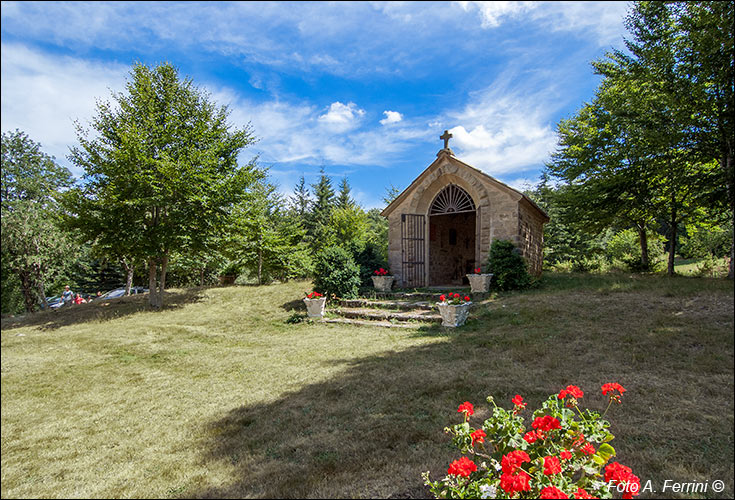Dalla Valle del Solano all’Uomo di Sasso
cultura e natura in un itinerario sul crinale e sulle pendici orientali del Pratomagno
Italiano
LE TERME DEL PRATOMAGNO
Lasciamo Cetica continuando a salire per la strada che conduce in Pratomagno e a Bagno di Cetica. Dopo circa cinque chilometri giungiamo a questa località. Un grande edificio, ampie radure erbose con maestose piante e una cappella nel prato (nella foto) contraddistinguono questo fresco luogo ricchissimo di acqua.
Un quadretto all'interno della cappella ci narra la leggenda secondo la quale nacque questo luogo e, indirettamente, qualche secolo di storia del Pratomagno. Vi sono raffigurati San Giovanni Gualberto, fondatore di Vallombrosa, San Romualdo, fondatore di Camaldoli, e tra loro, più in alto, un'altra figura: è l'anima di San Romolo martire, patrono di Fiesole. I due monaci si sarebbero incontrati in questo luogo in un imprecisato anno dell'XI secolo per discutere del destino delle anime casentinesi. Chi per primo ha scritto questa storia sapeva che i rapporti tra Camaldolesi e Vallombrosani non erano dei più rosei, per questo ha inserito San Romolo in veste di moderatore. Al termine dell'incontro, le tre sante figure si dissetarono con l'acqua che scaturiva abbondante da una sorgente nel luogo e, costatato quanta bontà e purezza avesse, la benedissero. Da quel momento quell'acqua oltre che buona divenne curativa, capace di depurare il nostro organismo e curare i reumatismi. Nacque così un luogo termale in Pratomagno: Bagno di Cetica. Queste proprietà si sono mantenute, così in epoca relativamente moderna è stato costruito l'edificio con funzione di albergo ristorante. Inoltre dispone di salette dove si possono immergere le gambe in piccole vasche. Solo le gambe, anche in estate quest'acqua non supera i 6-7 gradi.
Naturalmente l'incontro in questo luogo tra i fondatori di Camaldoli e Vallombrosa non può esserci stato. Quando Giovanni Gualberto sale da Firenze a Cerretaia, o Acquabella, come si chiamava all'epoca la zona di Vallombrosa (1036-1038, l'abbazia sarà fondata tra il 1050 e il 1060), Romualdo è morto da una decina di anni (1027). Le leggende, però, non nascono dal niente, non è da escludere che un incontro tra i loro successori ci sia stato, probabilmente alla fine del XII secolo o inizio XIII quando i rapporti tra questi due entità religiose si fanno più aspri. Non tanto per parlare del destino delle anime dei casentinesi, più probabilmente per suddividersi pacificamente il territorio casentinese, e non solo da un punto di vista spirituale. I vallombrosani si prendono il Pratomagno e dal Duecento, dalla loro abbazia posta sulle pendici nord del massiccio, vediamo iniziare la loro "discesa" sulla montagna che culminerà nel 1425 con l'acquisizione dell'Abbazia di Santa Trinita in Alpe, sulle pendici sud del Pratomagno, sorta quasi un secolo prima di Vallombrosa.
We leave Cetica continuing to climb the road that leads to Pratomagno and Bagno di Cetica. After about five kilometers we reach this locality. A large building, large grassy clearings with majestic plants and a chapel in the meadow (in the photo) distinguish this cool place full of water.
A small picture inside the chapel tells us the legend according to which this place was born and, indirectly, a few centuries of history of Pratomagno. There are depicted San Giovanni Gualberto, founder of Vallombrosa, San Romualdo, founder of Camaldoli, and among them, higher up, another figure: it is the soul of San Romolo martyr, patron saint of Fiesole. The two monks would have met in this place in an unspecified year of the 11th century to discuss the fate of the Casentino souls. Who first wrote this story knew that the relations between Camaldolese and Vallombrosani were not the most rosy, for this reason he inserted San Romolo as moderator. At the end of the meeting, the three holy figures quenched their thirst with the water that flowed abundantly from a spring in the place and, having ascertained how good and pure it was, they blessed it. From that moment that water as well as good became curative, capable of purifying our body and curing rheumatism. Thus was born a thermal place in Pratomagno: Bagno di Cetica. These properties have been maintained, so in the relatively modern era the building was built to function as a hotel restaurant. It also has rooms where you can immerse your legs in small tubs. Only the legs, even in summer this water does not exceed 6-7 degrees.
Naturally, the meeting in this place between the founders of Camaldoli and Vallombrosa could not have taken place. When Giovanni Gualberto went up from Florence to Cerretaia, or Acquabella, as the area of Vallombrosa was called at the time (1036-1038, the abbey was founded between 1050 and 1060), Romualdo had been dead for about ten years (1027 ). The legends, however, do not arise out of nowhere, it cannot be excluded that a meeting between their successors took place, probably at the end of the 12th or early 13th century when the relationship between these two religious entities became harsher. Not so much to talk about the fate of the souls of the Casentino people, more likely to peacefully divide the Casentino territory, and not only from a spiritual point of view. The Vallombrosans take the Pratomagno and from the thirteenth century, from their abbey located on the northern slopes of the massif, we see the beginning of their "descent" on the mountain which will culminate in 1425 with the acquisition of the Abbey of Santa Trinita in Alpe, on the southern slopes of the Pratomagno, built almost a century before Vallombrosa.























































